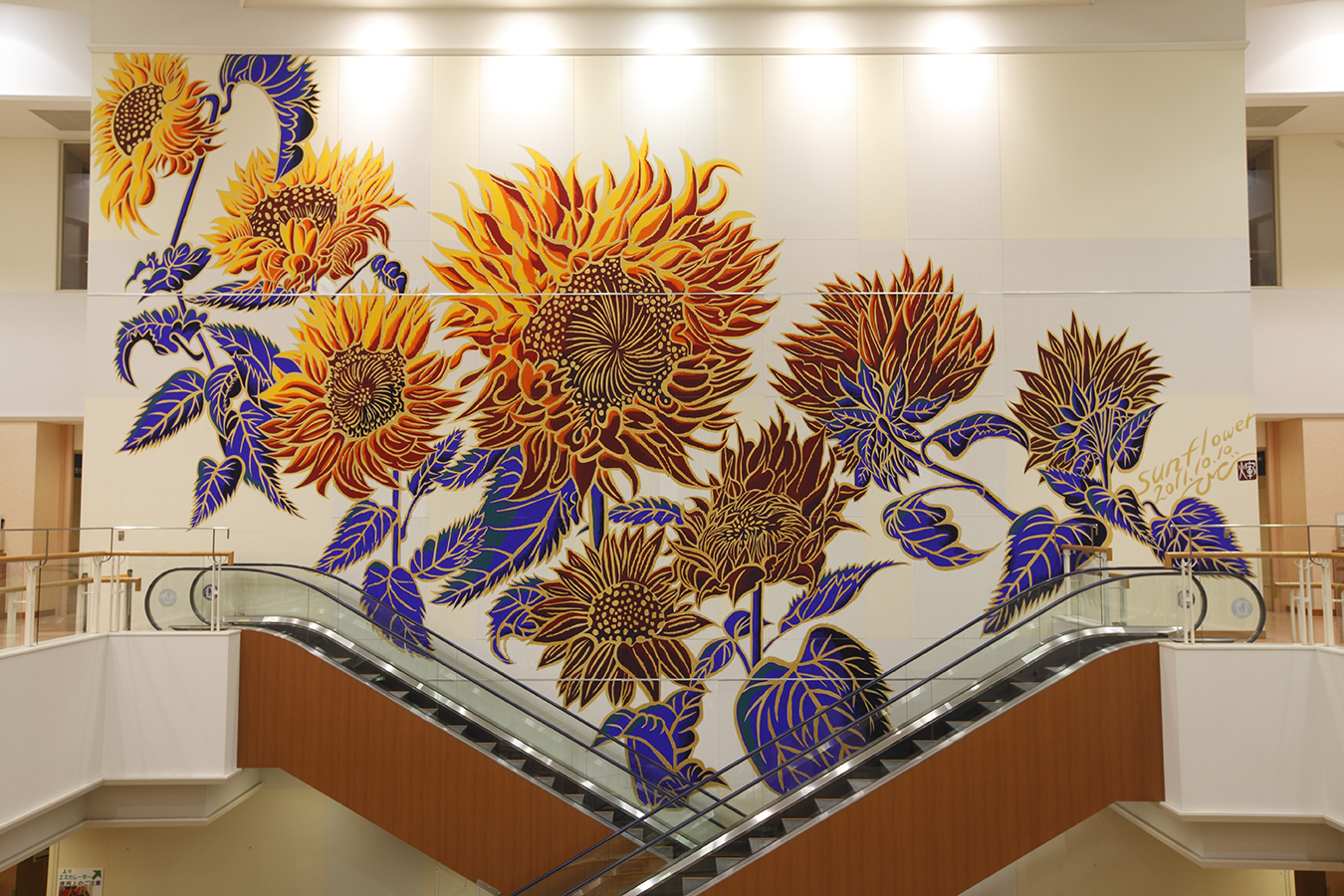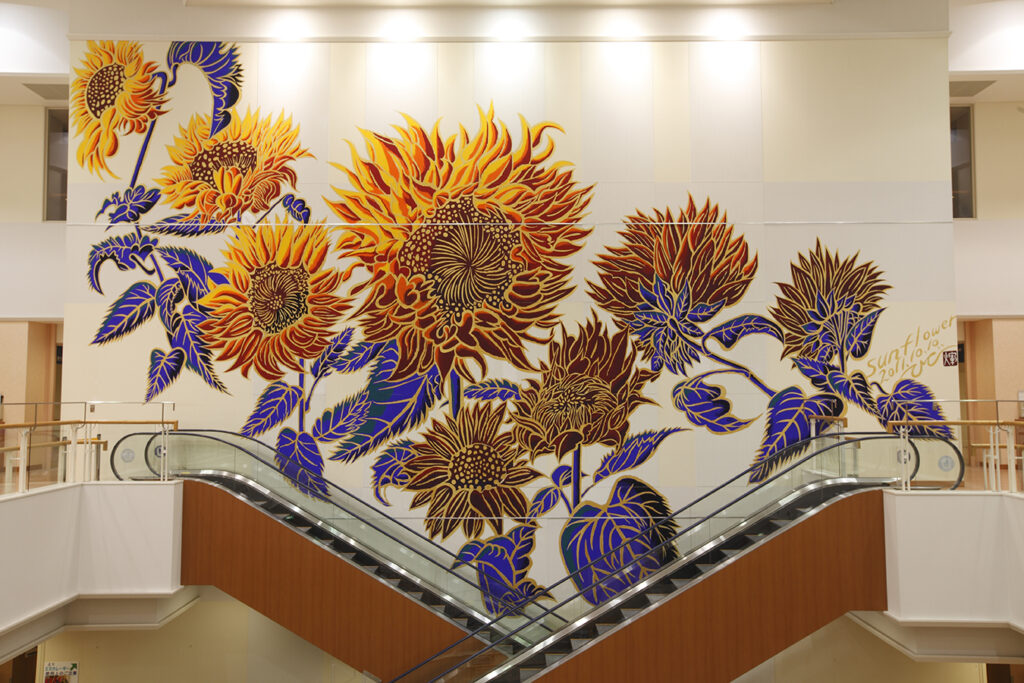
Artist Hideki Kimura depicts the vitality of plants and animals through bold “lines” and vivid “colours”. His work captures the life force inherent in his subjects, engages in dialogue with space, and manifests unrestrained expression that transcends the constraints of walls and ceilings. The primal experience of drawing on roadsides in childhood, his deep connection with rock music—the impulse at its root freely transcends the boundaries of era and genre, continuously resonating with the rhythm of life. To paint is to live. Even now, past eighty, Kimura, brush in hand, gazes not at the past or future, but at the energy pulsing in this very moment. Boldly, lightly, and earnestly. We too wish to walk alongside him on this journey to capture the pulse of life.
Q: First, could you tell us about your formative experience with art?
As a child, I often drew pictures on the roadside. That is the origin of my painting. I enjoyed drawing in public, delighted by the praise, and drew freely. These childhood experiences connect to the present.
Q: I understand you graduated from Kyoto City University of Arts (formerly Kyoto City University of Fine Arts). Why did you choose the Design Department?
I’m originally from Izumiotsu in Osaka’s Senshu region. That area has a very pragmatic character; if you dared say you wanted to be a painter, you’d immediately be labelled a “painter” in that atmosphere. The term “artist” carried discriminatory connotations, implying “poverty” or “unable to make a living”. So I resolved never to become a painter. I chose the Design Department because I wanted to create art that could be commercialised.
Q: Were there any artists who influenced you?
My student days coincided with the emergence of Andy Warhol. He completely overturned the existing concept of art. It was a time when everyone started saying things like, ‘The Coca-Cola bottle right in front of you is art,’ or ‘The apple on the television is more real than a real apple.’ Of course, Warhol had a huge influence on me, but so did artists like Robert Rauschenberg and Roy Lichtenstein.
Q: Andy Warhol was also innovative in his production and sales style. Were you influenced by that aspect too?
Yes, I was. I found his approach very interesting: not being bound by conventional methods, opening up the production process, and treating that process itself as a work of art. As he was originally a designer, I also sympathise with the fact that he created a trend of “designers working in art”. I believe that art should fundamentally question and express the essence of humanity. However, I feel that, at some point, it became something of a pretentious display, detached from society and merely seeking to shock… I believe that art should connect more with people.
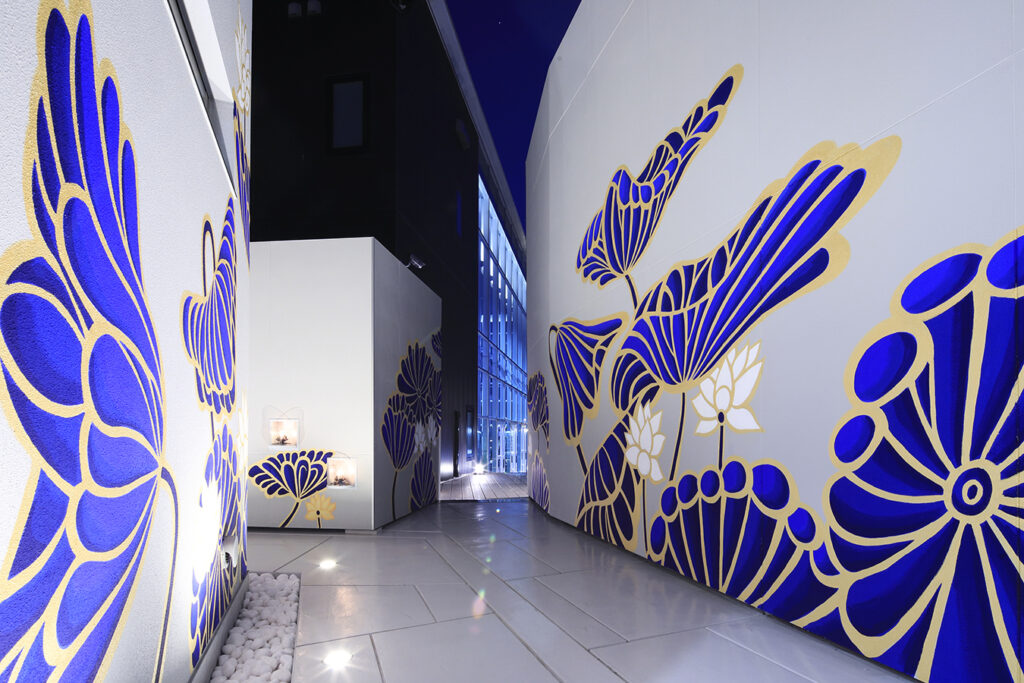
Q: Please tell us how you became a music producer after graduating from university.
After graduating, I remained at the university as a part-time lecturer. But this was the era leading up to the 1965–70 Security Treaty protests, when many universities were barricaded and almost no classes were held. Given that situation, I decided, “Let’s go out into the streets.” Just as Shūji Terayama said, “Abandon your books, go out into the streets,” we too went out to express something. So we started organising various gatherings. Musicians like Fujio Yamaguchi happened to join these gatherings. It was precisely the period when the group sounds era was ending and more accomplished bands were emerging. While there were many folk singers, bands with electric guitars stood out particularly. Gradually, our gatherings transformed into something resembling a rock festival. That was how I became involved with rock music.
Q: What was the situation with rock festivals overseas at that time?
Festivals like Woodstock, Altamont, and the Isle of Wight had taken place slightly before our activities. That was around 1967 to 1968. We started doing something similar from 1968 to 1969. We hadn’t originally planned to organise rock festivals, but influenced by these overseas festivals, our gatherings gradually evolved into a festival-like format.
Q: I see. After many years as a music producer, I understand you began working as a painter after turning sixty. What prompted that decision?
Having produced rock events for so long, I harboured a desire to challenge myself to create something more directly. As I approached sixty, that feeling grew stronger, and I resolved to return to my roots: painting.
Q: There are many forms of painting, but why choose murals over canvases?
That relates to the childhood experience I mentioned earlier. I never particularly liked painting on canvas; I wanted to express myself in ways that went beyond the frame. Murals were perfect for that. By chance, a younger friend was setting up a new office and asked, ‘Would you paint something on the wall?’ So that’s where I started.
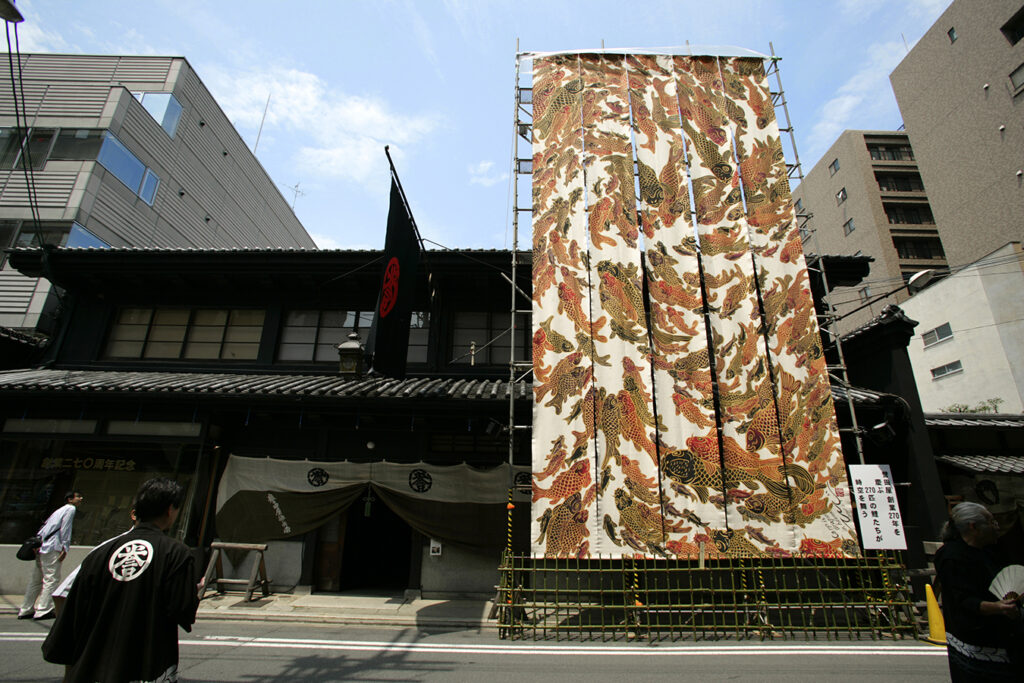
Q: What was that first piece like?
I painted a mother and calf rhinoceros. Psychedelic art was popular at the time, so I started by outlining the rhino in gold and filling it in with shocking pink. However, there was a German-style column in the room, and the atmosphere just didn’t match. So, I covered the shocking pink with a burnt brown colour close to the column’s hue. After finishing it, I showed it to a friend who said it looked cool. That’s when I decided to make this my style.
Q: I feel the motifs in your work, like carp, elephants, and peacocks, are quite unique. How do you choose your subjects?
When painting murals, I try to choose motifs that are auspicious and lucky. What I always aim for is to create paintings that feel airy, where light seems to pour in. I aim for paintings that evoke a sense of light and air, bringing hope to the viewer’s heart.
Q: I imagine it depends on the wall size, but how long does a piece typically take to complete?
Once I start painting, it goes incredibly quickly. I prepare a small preliminary sketch, but on-site I paint directly, adapting to the wall’s dimensions. I use a tool with chalk attached to a bamboo stick – this stems from my childhood experience drawing life-sized pictures on the pavement. That sense remains in my body, allowing me to balance large paintings well even now.
Q: Do you have criteria for choosing colours, or meanings you imbue in specific hues?
The colours we see are reflected light, concealing other colours beneath them, right? I’m conscious of that principle of colour. I particularly emphasise complementary colour relationships – combinations like yellow and purple, sky blue and pink – aiming to express them stylishly. I strive to express these often flashy opposites in a refined manner, avoiding any hint of vulgarity.
Q: Do you listen to music while creating?
When applying colour, I often listen to hard rock like Deep Purple or Led Zeppelin. Conversely, when sketching forms, songs with powerful vocals, like Elvis Presley, suit my mood.
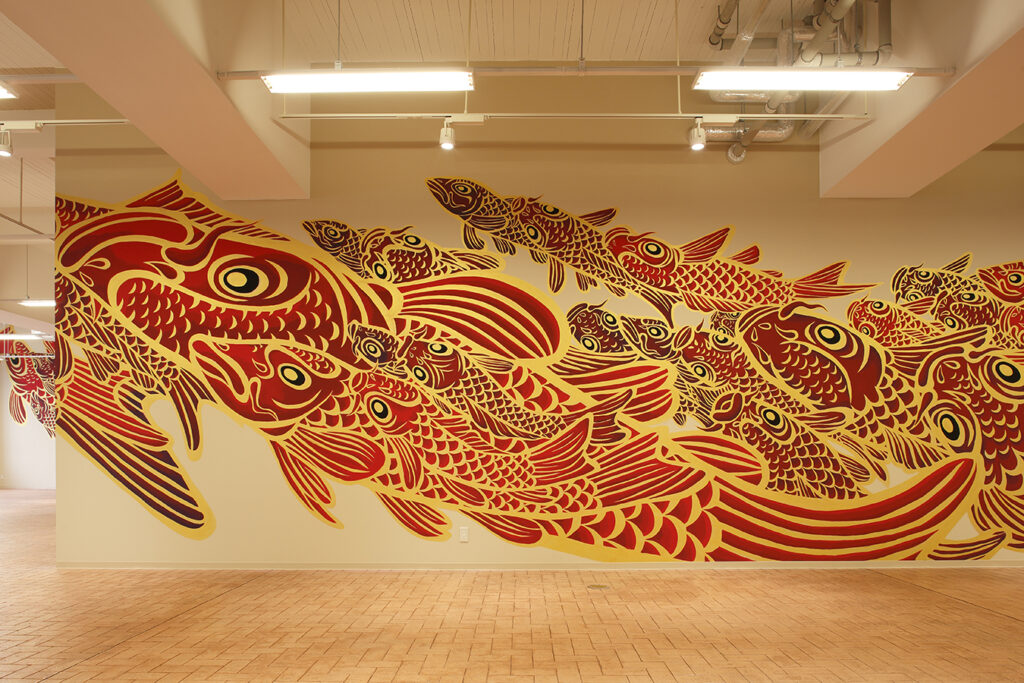
Q: Could you share any aesthetic sensibilities or philosophies you hold dear when progressing your work?
I always bear in mind the attitude of “like a willow, following the body’s inclination”. I believe it’s best to proceed naturally, without forcing decisions.
Q: Has your extensive involvement with many musicians influenced that way of thinking?
I wonder. The world of music involves more technique and rules than painting, doesn’t it? So, one expends considerable effort mastering techniques and overcoming rules. Painting, on the other hand, isn’t bound by technique and rules to that extent. Precisely because I studied fine art first, I think I’ve naturally become able to “break free from the frame”.
Q: Could you tell us about any pivotal works or events in your career as an artist?
Since starting my work, I’ve generally accepted every commission without refusal. I didn’t want to become someone who could only draw one thing. Then, as the Year of the Dragon approached, requests for dragon paintings suddenly surged. But I’ve always had reservations about drawing non-existent creatures, so I’d consistently avoided dragons. Of course, by referencing dragons painted by predecessors, I could produce something resembling one. But that wouldn’t feel like “my dragon”. However, the sheer volume of requests made me think, “Well, this might be too good an opportunity to pass up” (laughs). It was then that the phrase “Dragon Gate” suddenly came to mind. If I based it on this tale of a carp transforming into a dragon, perhaps I could express dragons within my own worldview. Since then, whenever someone asks me to draw a dragon, I always propose using the “Dragon Gate” theme and depicting a carp.
Q: What do you most wish to express through your work, Mr Kimura?
What I value most is conveying energy. I believe beauty arises as a result of that energy. I don’t consciously aim to paint “good things”; rather, I hope viewers will find beauty within the energy itself as I move my brush with abandon. My paintings feel akin to children’s artwork. I still paint without analysing or overthinking, just as I did as a child. I feel I am an extension of that childhood self, who kept painting because I was delighted when my pictures were praised. So, naturally, receiving praise still makes me happy and motivates me to paint more.
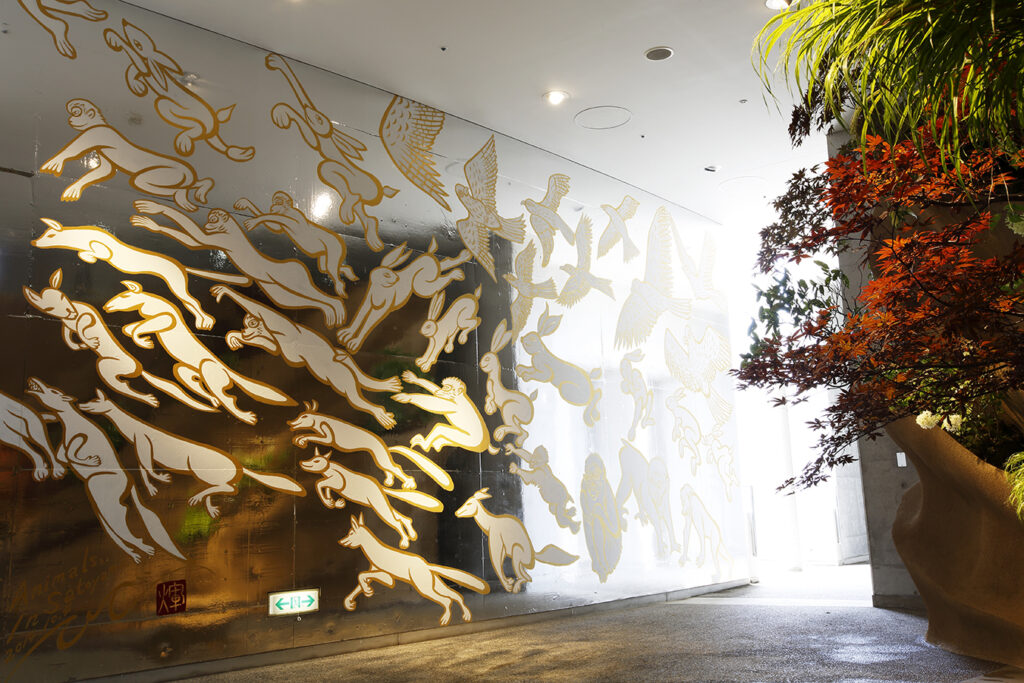
Q: You have painted in various countries and cities. Do the atmosphere of the town or the mood of the people influence your work?
Rather, the more I travel abroad, the more I feel compelled to confront myself. Take my visit to Canada, for instance. Japanese artists painting there often gravitate towards Japanese motifs like cherry blossoms or Mount Fuji. I deliberately chose the local king salmon as my subject instead. I believe that by depicting subjects unique to that place, my own energy and a Japanese essence blend in, creating more interesting work.
Q: Are there any locations or collaborations you’d like to try in the future?
Personally, I love sports, so I’d like to try painting in places like football pitches or stadiums. It would be wonderful to express that intensity within a space where the energy of the players collides.
Q: That sounds like it would suit your style, Mr Kimura. You mentioned Canada earlier; if you have any thoughts on the reactions or reception overseas, please share them.
People overseas often describe my murals not as “art” but as “design”. They say things like, “This design is interesting”. I really like that perspective. I don’t place much faith in the term “fine art”. It feels a bit odd to even say “pure” from my own mouth. That’s why I’m fundamentally interested in painting from a design perspective. In Japan, some people think it’s disrespectful to view art as “design”, but I believe design and art are one and the same.
Q: In 2015, you served as the overall producer for the “Rinpa Rock” event commemorating the 400th anniversary of the birth of the Rinpa school. I imagine your main activity now is as a painter, but do you still maintain a connection with music?
Whereas painting is a spatial art, music is a temporal art, isn’t it? As I’ve grown older, this temporal art has gradually diminished in my life, and I’ve come to feel a certain dissatisfaction with a world where, like painting, only the result remains. That’s why I always feel the urge to do something time-limited, and that sentiment led me to produce events like “Rinpa Rock”.
Q: Are there any themes you’re particularly focusing on recently, or motifs you’re currently absorbed in?
At this age, I’ve found myself strongly drawn to Japanese painting from the Muromachi period through to Sotatsu’s era for the first time. Whereas contemporary Japanese painting is influenced by Western painting, the Japanese painting of that period placed great importance on contours and lines. This aspect resonates deeply with the origins of my own creative practice, and I find it immensely compelling. The development of manga culture in Japan is surely not unrelated to this aesthetic sensibility that values outlines. I believe the Japanese sensibility, where the ability to draw outlines meticulously is considered “skilled drawing”, nurtured the expressive form of manga, which relies on lines.
Q: If there is anything you wish to convey to the next generation of Japanese painters, please share it.
I hope they paint more freely, unconstrained by genres like “Japanese painting” or “Western-style painting”. They should adopt a broad perspective, recognising that all paintings created by Japanese artists are essentially Japanese painting. Rather than debating within sectarian boundaries, I wish they would engage with the act of “painting” itself from a more level-headed viewpoint. In our modern era, where deepening specialisation often leads to insularity, I firmly believe that free expression, unshackled by fixed notions, holds the key to forging the next era.
Q: Lately, it seems more people are bound by rules, seeking certainty out of fear of inefficiency or failure. What are your thoughts on this trend?
Fundamentally, the concept of “failure” only arises because we have a predetermined notion of “success”. That very mindset strikes me as flawed. We tend to label anything deviating from an ideal form as a “failure”. Yet fundamentally, what constitutes failure isn’t clearly defined. Isn’t it merely the perspective of those holding an image of success that dictates this? Of course, simple mistakes exist. However, in creative endeavours, I believe it’s impossible to judge whether the act of creating itself is a failure.
Q: You also mentioned that ‘art should connect more deeply with people.’ What message do you wish to convey to individuals and society through your work?
A consistent thread running through my work is the message: ‘Let us cherish the Earth.’ Whilst expressing individual energy, I ultimately champion this grand theme of ‘Love Earth.’ This theme has been incorporated into my work thus far and will remain the core foundation of my creative endeavours going forward.
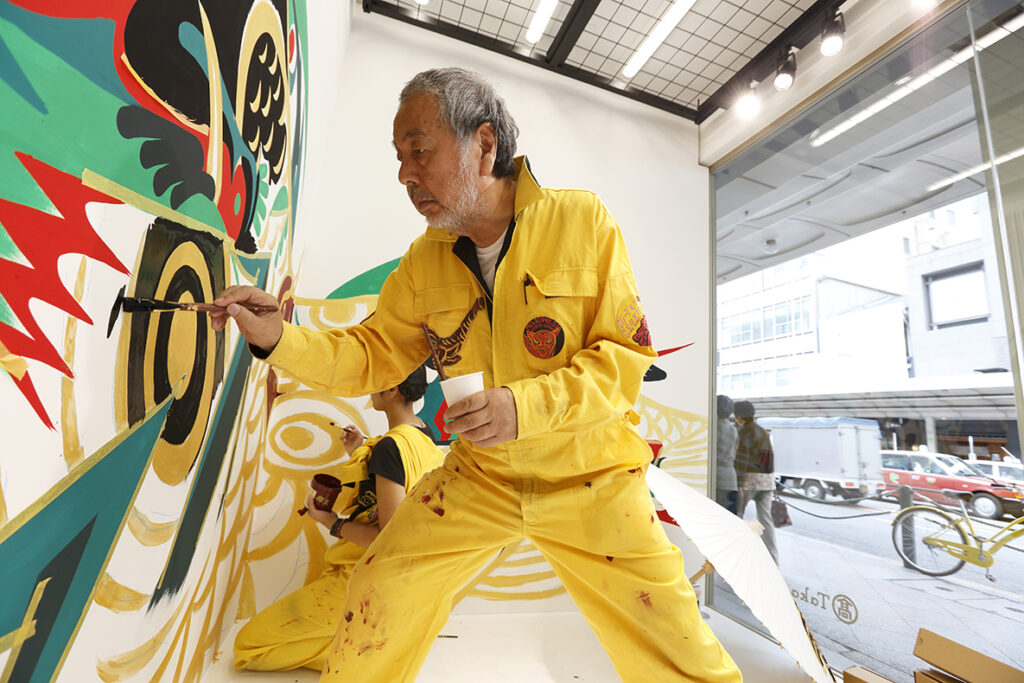
PROFILE
Painter/Hideki Kimura
Born 1942 in Izumiōtsu City, Osaka Prefecture. Graduated from Kyoto City University of Arts, Department of Design, later serving as a lecturer there. During the dawn of Japanese rock, he produced numerous legendary events as an organiser. Turned painter upon reaching sixty. His murals adorn over 250 locations domestically and internationally. His life journey alongside rock music is reflected in his vibrant, dynamic canvases. Rather than facing a canvas in his studio, he seeks to paint in the “live” streets. An unconventional artist who champions the ultimate amateurism. His collections include “Living As Is”, “Self-Forgetting Absorption”, and “LIVE”.

